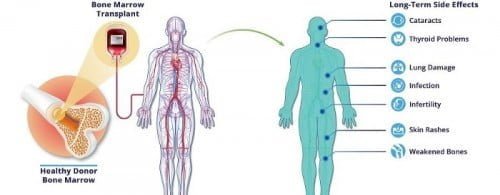BONE MARROW TRANSPLANT IN INDIA
A bone marrow transplant is done to replace damaged bone marrow that may have been caused due to disease, infection or chemotherapy. Here, blood stem cells are transplanted which travel to the bone marrow where they promote the growth of new bone marrow by producing new blood cells. Bone marrow is responsible to create red blood cells, white blood cells, platelets, etc.
Causes of damaged Bone Marrow:
- Aplastic anemia is where the bone marrow stops making new blood cells
- Leukemia, Lymphoma and Multiple myelomas
- Damaged bone marrow from chemotherapy
- Congenital Neutropenia is a disorder causing recurring infections
- Sickle cell anemia
- Thalassemia
More About Treatment
Types of Bone Marrow Transplant
Autologous Transplants: This procedure involves the use of a person’s own stem cells, wherein, the cells are harvested, frozen and stored, then infused back into the patient after intensive therapy. Once the treatment is completed, the cells are returned to the body. However, this technique is rarely used but reduces some serious complications.
The procedure typically takes about an hour. The stem cells after entering the bloodstream, travel to the bone marrow and begin to produce new blood cells, and this process is referred to as ‘Engraftment’.
Using cells from the person’s own body during your stem cell transplant offers advantages over receiving stem cells from a donor such as cases of incompatibility between the donor’s cells and recipient’s cells do not occur in cases of an autologous stem cell transplant.
Why You May Need An Autologous Transplant?
An autologous stem cell transplant is used to treat the following disorders:
- Hodgkin’s lymphoma
- Myeloma
- Non-Hodgkin’s lymphoma
- Plasma cell disorders
Allogenic Transplants: This procedure involves the usage of cells from a donor and here the donor must be a close genetic match to the recipient. In fact, the success rate is dependent on how close the match is.
An Allogenic stem cell transplant uses healthy blood stem cells from a donor to replace the diseased and damaged bone marrow. A donor may be a family member, an acquaintance or someone who is unrelated. The stem cells, in this case, can be collected from the donor’s blood or bone marrow within a donor’s hipbone as well as from a donated umbilical cord.
Here it is important to note that before undergoing an Allogenic stem cell transplant, a high dosage of chemotherapy or radiation is incorporated to destroy the diseased cells and prepare the body for the donor cells.
Why You May Need An Allogenic Transplant?
An allogeneic stem cell transplant is used to treat the following disorders:
- Acute leukemia
- Adrenoleukodystrophy
- Aplastic anemia
- Bone marrow failure syndromes
- Chronic leukemia
- Hemoglobinopathies
- Hodgkin’s lymphoma
- Immune deficiencies
- Inborn errors of metabolism
- Multiple myelomas
- Myelodysplastic syndromes
- Neuroblastoma
- Non-Hodgkin’s lymphoma
- Plasma cell disorders
- POEMS syndrome
- Primary amyloidosis
Umbilical Cord Blood Transplants: Umbilical Cord contains the cord blood and placenta of a newborn child. It can be collected and frozen for later use. Cord blood contains hematopoietic stem which can produce different cells such as red blood cells, white blood cells, and platelets. They are responsible for maintaining blood production in the body and have been used for many years in bone marrow transplants to treat blood diseases such as Leukemia.
Cord blood cells are also immunologically sound as they have not been exposed to infections. This makes them more tolerant against a tissue mismatch between the cord cells and the patient. Thus, they can be used to transplant patients who do not have a fully matched available donor as well.
Haploidentical Transplants: Haploidentical transplants can often be performed more than traditional unrelated donor transplants. Relatives may be eligible to make a donation on a short notice, which may be less likely for unrelated donors.
For donors and patients alike, the procedure for a Haploidentical transplant is much the same as for a standard Allogenic transplant. However, the main difference is that in this type of transplant, patients receive a high dosage of chemotherapy days after the transplant. Success rates for Haploidentical transplants are similar to those for conventional transplants.
FAQ’s
What is a bone marrow transplant?
Bone marrow transplant (BMT) is a procedure to treat certain cancers and various diseases of blood and bone marrow.
What does it involve?
BMT involves taking healthy bone marrow stem cells from a donor and placing them into a patient’s bloodstream.
Why would someone need a bone marrow transplant?
Bone marrow transplants help treat cancers and diseases of the blood and bone marrow by replacing unhealthy stem cells with healthy ones. It is also helpful for people whose bone marrow has been destroyed by chemotherapy or radiation treatment. It also treats diseases that cause a person’s bone marrow to stop functioning.
How long does it take to recover from a bone marrow transplant?
Every person’s situation is different but most people can expect to spend at least 30 days in the hospital when your body rebuilds the immune system. Once the immune system is strong enough the rest of the recovery can be continued at home. It can take several more months or even years after BMT for your immune function to fully recover.







